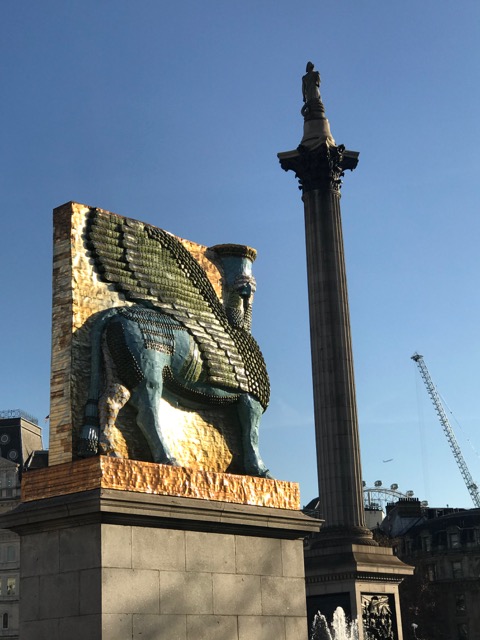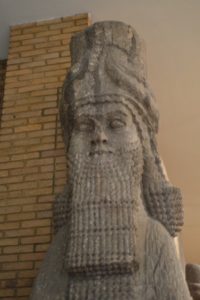
The fourth plinth in Trafalgar square was meant to have an equestrian statue of William IV, but funding could not be raised (this was in 1841, just four years after his death). Over the next 150 years, various proposals for permanent statues on the plinth came and went (and the space might still be used for HMQ when she eventually turns up her royal toes), then in 1998 the RSA commissioned three temporary sculptures (including a witty Rachel Whiteread cast of the plinth itself) and from 2005 there have been a succession of commissions.
These included Yinka Shonibare’s “Nelson’s Ship in a Bottle” (now outside the National Maritime Museum in Greenwich*), Hans Haake’s “Gift Horse”, and Marc Quinn’s “Alison Lapper Pregnant”. There was also a wonderful Anthony Gormley project where, over 100 days, 2400 members of the public were each given an hour each on the plinth to do what they liked.
For the past two years (and due to be replaced early in 2020) the Iraqi-American artist Michael Rakowitz has been displaying a piece from his project “The Invisible Enemy Should Not Exist”. This is an attempt by Rakowitz to recreate some of the more than 7,000 objects from Iraqi culture which have been lost forever: some were looted from the Iraq Museum in 2003, others were destroyed at archaeological sites across the country during the Iraq War, still more were destroyed during the period of the Islamic State.
The Trafalgar Square piece is a lammassu, a protective spirit of ancient Assyria, a winged bull, with the head of a man. Rakowitz’s reconstructions are made from recycled packaging from Middle Eastern foodstuffs and this artwork is made from 10,500 empty date syrup cans: a once-renowned Iraqi industry now decimated by war. On the side of the Lamassu is an inscription in Cuneiform which reads: “Sennacherib, king of the world, king of Assyria, had the inner and outer wall of Ninevah built anew and raised as high as mountains.”
In the British Museum you can walk between other lammassu, built as guardians to entrances to Assyrian palaces, including the biggest objects in the museum, the giant ‘Winged bulls’ from the palace of Sargon II at Khorsabad (close to modern day Mosul, ironically the ‘capital’ of the Isis ‘caliphate’).

*Poor William IV. He eventually got a statue, near the top of the old London Bridge, which was moved to the National Maritime Museum in 1935. This is now completely upstaged by Shonibare’s work.

